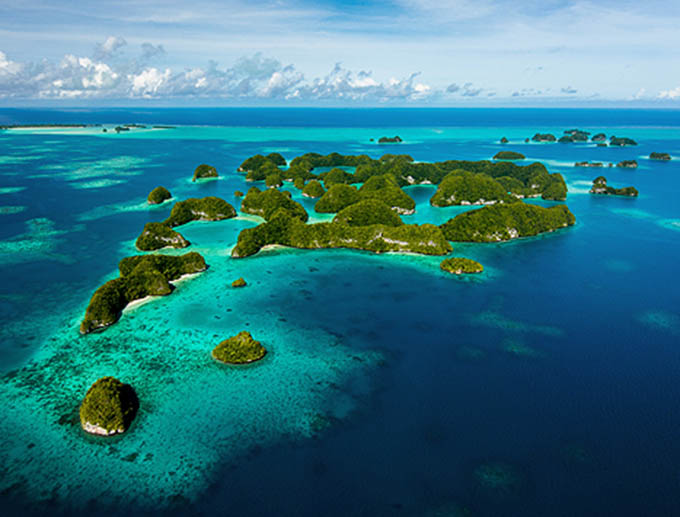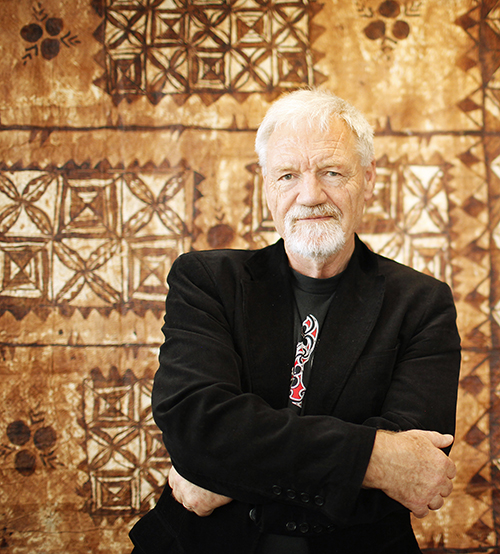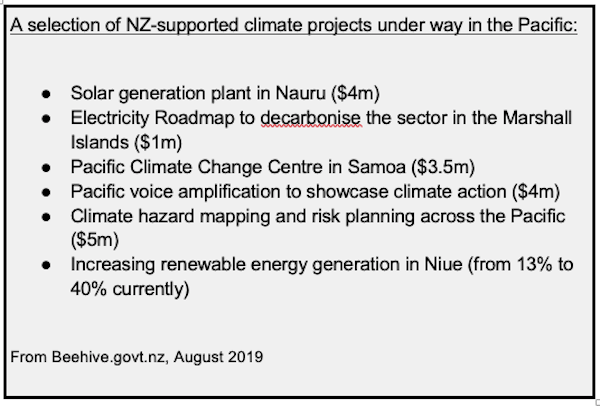
New Zealand has long had a privileged relationship with its Pacific neighbours. Now, in the dawning era of the climate crisis affecting millions of lives across the Pacific, the country has its helping hand outstretched. But with the controversial record of climate adaptation and mitigation strategies, does this hand have an ulterior motive? Matthew Scott investigates.
SPECIAL REPORT: By Matthew Scott
The beach is vanishing, one day at a time. The sea approaches the coastal village. It will not be negotiated with.
With seawater flooding the water table, crops that have fed the islanders for centuries are losing viability. The problem is invisible, under the people’s feet. But it demands change.
Each year, the cyclones have seemed to get more volatile and less predictable. What used to be a cycle of weathering the storm and rebuilding has become a frenetic game of wits with the elements.
In 2012, 3.8 percent of the total GDP of the Pacific Islands region was spent on the rebuilding efforts needed after natural disasters.
In 2016, that number had risen to 15.6 percent.
The effects of climate change are increasing the volatility and unpredictability of tropical cyclones in the Pacific.
That number has nowhere to go but up.
This story is playing out all over the Pacific, where economically vulnerable nations are some of the first to become victims to the encroaching climate crisis. Countries like Kiribati and Tuvalu, which have contributed least to the carbon emissions driving climate change, are on the brink of becoming its first casualties.
With millions of lives in the balance, this is a moral issue. New Zealand has responded according to its conscience.
Or at least it appears so.
The New Zealand Aid Programme sends 70.7 percent of its aid to countries in the Pacific. This is a higher proportion of our foreign aid budget than any other country. As such, New Zealand is inextricably entwined with funding and encouraging processes of climate adaptation and mitigation in the region.

However, recent findings from the studies of Professor Patrick D Nunn from the University of the Sunshine Coast in Queensland, Australia, suggest that the most common forms of climate aid to Pacific nations breed economic dependency and fail to help them create a sustainable and self-reliant future.
On the surface, New Zealand’s climate aid policies seem like a life preserver to its drowning neighbours. But when the programme is considered in the long-view, does that life preserver come with a dog collar?
Ruined sea walls line the beaches of the South Pacific, a visual reminder to the people of the islands that the promise of help is sometimes broken.
Why should NZ help?
New Zealand has long played a custodial role in the Pacific. A shared colonial history and geographical location has created a familial bond between New Zealand and countries like the Cook Islands, Samoa and Tonga.
Employment opportunities stimulated immigration to New Zealand after World War Two, when the NZ government opened its doors to the Pacific to fill labour shortages. Soon, the industrial areas of New Zealand cities were centres of the Pacific diaspora.
Nowadays Auckland is the biggest Pasifika city in the world.
But there was always a two-faced element to New Zealand’s treatment of the Pacific. It welcomed Pacific people in on the one hand, but then punished them and sent them away with the other.
Norman Kirk’s government introduced the Dawn Raids in 1973, when crack police squads stormed homes and workplaces looking for overstayers – countless migrants from the Pacific were separated from their families, lives and livelihoods.
Between 2015 and 2019, the Ministry of Foreign Affairs and Trade provided $200 million in climate aid to the Pacific.
Does the same flavour of double-dealing hang over New Zealand’s climate aid programme?
“People argue that aid is buying influence,” says Professor Patrick D Nunn. “I don’t think they are far off the mark.”
New Zealand’s motivations for climate aid in the Pacific are murky when the communication within the government bodies responsible is studied.
“The region is also that part of the world where our foreign policy ‘brand’ as a constructive and principled state must most obviously play out,” wrote NZ’s Ministry of Foreign Affairs and Trade (MFAT) in its October 2017 Briefing to an Incoming Minister.
This suggests an ulterior motive to the helping hand. The MFAT website says that strengthening New Zealand’s national “brand” is in order to promote New Zealand as a “safe, sustainable and stable location to operate a business and to invest”.
So New Zealand may have self-interest at the heart of its movements in the Pacific. As a capitalist nation holding its breath through a decades-long wave of neoliberalism, this is no surprise.
Where is the money going?
But that doesn’t mean that New Zealand’s climate aid in the Pacific cannot have altruistic effects. Surely it is the outcome rather than the intention that ultimately matters.
However, it is still necessary examine where New Zealand’s money is going.
A 2020 study from Professor Nunn and a group of other academics casts doubt on whether current modes of climate adaptation can effectively promote long-term solutions for the islands.
“It’s unhelpful in the sense that it’s implicitly encouraged that Pacific Island countries don’t build their own culturally-based resilience,” Professor Nunn says. “It’s encouraged that they adopt global solutions that aren’t readily transferable to a Pacific Island context.”
One of the more visible examples is the ubiquitous sea wall. Sea walls protect coastal communities from rising sea levels throughout New Zealand, so it seems obvious that they could do the same job for Pacific neighbours.
But New Zealand invests in building its walls to stand for the long-term, and the country has access to the capital and human resources needed to maintain them.
This is not always the case in the developing countries of the South Pacific.
“Usually there’s not enough data to inform the optimal design of sea walls,” says Professor Nunn. “So the sea wall collapses after two years. Then the community struggles to find funds to fix it because they are not part of the cash economy.”
Professor Nunn blames this recurring issue on the short-sightedness of foreign aid programmes from the governments of developed countries in the region.
“You can’t uncritically transfer solutions from a developed to a developing country context – however obvious they seem.”

Academic and journalist Professor David Robie, the recently retired director of the Pacific Media Centre, sees New Zealand’s relationship with the Pacific as neocolonial.
“We build sea walls where they would plant mangroves,” he says. Mangroves, of course, don’t require upkeep, and they are a solution that people in the Pacific have used for centuries. They might not always fulfil the urgent interventions required during the climate crisis, but as New Zealand seeks to advance our “brand” in the Pacific, do we give them due consideration, or do we fall back on our own western solutions by default?
“It would have been better to not have had such a neocolonial approach,” says Professor Robie. “We could have encouraged the Pacific countries to be a lot more self-reliant.”
Short-term solutions for long-term problems
According to an MFAT Official Information Act release on climate change strategy, climate aid consists of 190 different activities across the Pacific. Of these activities, the largest focus is put on agriculture (25 percent), followed by energy generation and supply (20 percent) and disaster risk reduction (12 percent).
With the long-term projections of sea levels rising, are these areas enough to safeguard our Pacific whanau long into the future?
Professor Nunn spoke about plans by Japanese foreign aid to divert the mouth of the Nadi River in Fiji in order to stop the growingly frequent flooding of Nadi town.
“It would be far more useful for the Japanese government to develop a site for the relocation of Nadi town,” Professor Nunn said. “Somewhere inland, somewhere in the hinterland. Put in utilities and incentivize relocation of key services – because the situation is not going to improve. In 10-15 years, large parts of Nadi town are going to be underwater.”
So it goes across the Pacific.
New Zealand’s strategies of capacity building and disaster management are noble on the surface, but are we arranging deck chairs on the Titanic?
Climate change is an epoch-defining force that is inevitably going to render swathes of the globe uninhabitable. We can fund short-term adaptation to these issues and feel better about ourselves and our Pacific “brand”, but the real solutions lie in establishing humane systems of relocation around the Pacific.
Some of this comes in the form of increasing New Zealand’s own quota for climate migrants seeking asylum in New Zealand. For countries that consist of primarily low-lying atolls such as Kiribati, leaving their ancestral homeland will one day sadly be the only option.
Other nations such as Fiji and Samoa have the capacity to weather the storm if development is focused in the right direction – the gradual relocation of population centres inland, away from the risks of increasing flood frequency and rising tides.
MFAT has stated in an Official Information Act release of July 2019 that three quarters of their investment into climate aid “will go towards supporting communities to adapt in situ to the effects of climate change, which will enable them to avert and delay relocation”.
These goals are stuck in the short-term. This is procrastination on an international scale. The effects of climate change are no longer just theories, or nightmares that may or may not come true.
There is a clear road map to a future in which many areas in the Pacific are in peril. New Zealand has a moral duty to make sure that the effect of its aid helps not just the current members of Pacific whanau, but also the generations to come.
Examining NZ’s aid
In July, 2019, an inquiry was launched by the Foreign Affairs, Defence and Trade Committee into Aotearoa’s Pacific aid. The committee examined every facet of how the lion’s share of our foreign aid budget is spent. With Pacific aid, this means a discussion of climate change is inevitable.
Their findings were released last August.
Overall, the committee paints the picture of a considered approach to foreign aid, with New Zealand making an effort to take responsibility as the most developed economic power in our geopolitical bloc to bring about a world in which people have social mobility and human rights are protected.
Much of the report, however, centred around the committee’s recommendations as to how MFAT should proceed.
Some of these recommendations shine a light on the potential problems inherent to our regime of climate aid.
They recommended that the aid programme take steps to “more deeply engage with local communities, ensuring all voices within those communities are heard, and their viewpoints respected.” This suggests a certain level of overhanded detachment coming from New Zealand’s aid programme.
They also suggested that MFAT places a heightened emphasis on social inclusion step up efforts to make sure development is centred around locally-owned industry.
The committee also asked for public submissions.
Some of these provided perspectives that the committee themselves may have glanced over.
“Pushing New Zealand values into the Pacific—particularly when tied to monetary support—could be viewed as a renewed form of colonialism,” submitted one anonymous member of the public. Another raised that “greater engagement is needed with local communities to ascertain both their values and needs, and for aid to be appropriately tailored.”
These criticisms are not definitive proof of missteps on the part of the ministry. However, they are talking points that the ministry themselves seem unwilling to address.
When questions of neo-colonialism and unsustainable aid programmes were raised to the ministry, a spokesperson provided answers that glossed over the criticisms.
“Four principles underpin New Zealand’s international development cooperation: effectiveness, inclusiveness, resilience and sustainability,” said an MFAT spokesperson when asked if there was a risk of breeding economic dependency via New Zealand forms of aid.
“Their purpose is to guide us and those we work with in our shared aim to contribute to a more peaceful world, in which all people live in dignity and safety, all countries can prosper, and our shared environment is protected.”
It sounds admirable, and it places New Zealand on the right side of history. But it doesn’t answer the specific concerns that have been levelled at the aid programme – the fact that deliberately or not, New Zealand may be guilty of building a relationship of dependency with countries in the Pacific.
Are answers like these just a further attempt to bolster the “brand” that New Zealand is trying to sell to the Pacific, and indeed the rest of the world?

Pouring money into the problem
When New Zealand signed the Paris Agreement in 2016, we were putting ourselves forward as one of the countries committed to strengthening the global response to the burgeoning climate crisis. John Key pledged to provide up to $200 million in climate aid over the next four years. Most of this was focused on the Pacific.
The Paris Agreement recognised that the Pacific was indeed one of the world’s most vulnerable regions when it comes to the effects of climate change – this is for a multitude of reasons. There are the obvious, such as the fact that countries consisting of low-lying atolls such as Kiribati and the Marshall Islands are the most at risk from rising sea levels, but the reasons are as numerous as they are insidious.
Small populations reliant on a narrow array of staple crops and food sources put the people of the Pacific in a particularly precarious position. The effects of colonisation have left these countries socio-economically deprived and in thrall to developed countries like Australia, New Zealand, the United States and China.
So the reasons why the Pacific is so vulnerable to the crisis are complex and various. It therefore follows that the solutions to the crisis are as well.
Chief among these is shifting from expensive answers to the problem to those that don’t cost anything at all. Cashless adaptation could come in the form of education or placing a greater emphasis on indigenous solutions to climate change.
Steering the ship towards cashless adaptation would reduce vulnerable countries’ reliance on their wealthier neighbours.
Another solution is the slow relocation of coastal cities into the hinterlands of the countries, such as Fiji’s Nadi, where flooding in the central business district is becoming more and more frequent.
Foreign aid can play a part in encouraging and funding such projects, but at the end of the day, it is the governments of these countries themselves that hold the reigns. The city of Nadi will not be moved without the constant efforts of the Fijian government over the course of generations.
In their 2019 paper “Foreign aid and climate change policy”, Daniel Y Kono and Gabriella R Montinola claim that while foreign aid for climate adaptation and mitigation is on the rise, the manner in which it is employed may render it toothless and unable to make changes for the people of the Pacific in the long term.
The main reason for this conclusion is that there has been little to no evidence that foreign climate aid in Pacific nations can be correlated with Pacific governments enacting policies addressing the crisis.
It is arguable whether foreign aid can be expected to affect the policies of recipient governments. However, it is undeniable that solutions to climate change require the synchronised action from both suppliers and recipients of this aid.
Help comes on NZ’s terms
In order to plant the seeds for long-term viable responses to climate aid, New Zealand’s approach must consider the worldview of people in the Pacific.
Professor Nunn sees this as another form of developed countries employing neocolonial tactics in order to build relationships of dependency with countries in need.
“You cannot take your worldviews and impose them on people who have different worldviews and expect those people to accept them,” he said.
On many of the islands of the Pacific, the scientific worldview does not hold automatic precedence over spiritual and mythological views, as it does in the secular West.
Low science literacy and a stronger connection to nature through cultural tradition and ritual such as religion mean that if the sea level rises, people in the Pacific often tend to consider it a divine act.
Practitioners of foreign aid need to show cultural competency if their approach is going to be picked up by the people of the Pacific.
“You’ve got to understand why your interventions are failing,” says Professor Nunn. “You go in there and argue on the basis of science. Nobody in rural Pacific Island communities gives a stuff about science. What they understand is God. To ignore that and pretend that it’s not important is just going to result in a continuation of failed interventions.”
Understanding is the route to developing a system of long-term and sustainable examples of climate change adaptation and mitigation in the Pacific.
“Empowering Pacific Island communities means understanding them,” says Professor Nunn. “Not just what their priorities are, but also how they’ve reached those priorities.”
With crisis comes opportunity
Prior to 2020, climate change was on its way to being a top-priority issue to governments all over the world – particularly those in highly-affected regions like the Pacific. Then 2020 happened.
Covid-19 has dominated public talk for months and there are no signs of this changing any time soon. Big ticket issues like social inequality and climate change found themselves on the back-burner during the New Zealand election, and the same could be said in societies around the world.
The virus has brought global tourism to a standstill and threatened the safety of many already vulnerable indigenous populations. Both impoverished and tourism-reliant nations in the Pacific have been placed in drastically uncertain financial straits.
Although the rates of infection have been fortunately low across the Pacific, countries like Fiji and the Cook Islands have lost their main source of income – holidaymakers seeking a sun-soaked patch of white-sand beach.
The beaches are there waiting, but the planes haven’t begun to land yet.
With the threat of economic ruin hanging over their heads, Pacific nations’ climate change options have been reduced even further.
But from the perspective of analysing the problematic elements of New Zealand’s climate aid programme, there is a silver lining.
In April, MFAT reported that almost two-thirds of their development programmes had been affected by covid-19 in some way. In the Foreign Affairs, Defence and Trade Committee’s Inquiry into New Zealand’s aid to the Pacific report, it is said that recovery from this will require a range of responses, including stopping, reassessing and adapting, or re-phasing projects on an individual basis.”
Herein lies the opportunity.
The aid programme is on the verge of a massive shake-up, as MFAT reanalyses the best approach in a covid-stricken world. Now is the time for reassessment of our position as aid donors with the work of Professor Nunn in mind.
The committee’s report went on to say “the ministry pointed out that travel restrictions due to covid-19 mean that it will need to rely more heavily on local staff and expertise to provide aid. The ministry also hopes to move to a more adaptive and locally-empowered model.”
So it may be the virus that forces our hand and has the end result of more of the authority placed locally across the Pacific.
If we are indeed guilty of perpetuating a neo-colonial system of foreign aid, this could certainly be part of the remedy.
We are being given a nudge, if not a shove – an impetus to change. We can resist that or take the opportunity in our hands.
Now is the time to change, and ask the government for more equitable and sustainable forms of climate assistance in the Pacific.
Matthew Scott is an Auckland-based journalist for Newsroom who is interested in New Zealand’s place in the Pacific. He is a contributor to Asia Pacific Report and his stories can be seen here. Twitter: @mnscott1992









































